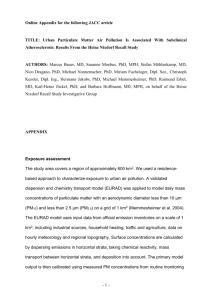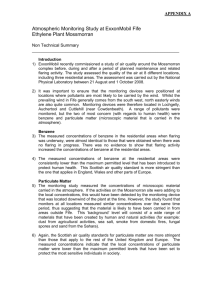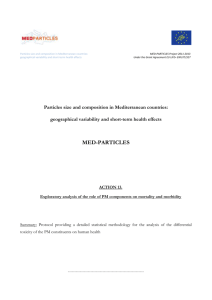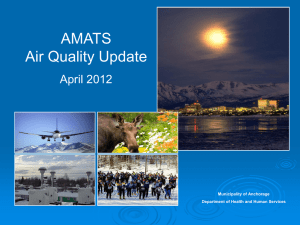Final protocol for the collection of data on PM components
advertisement
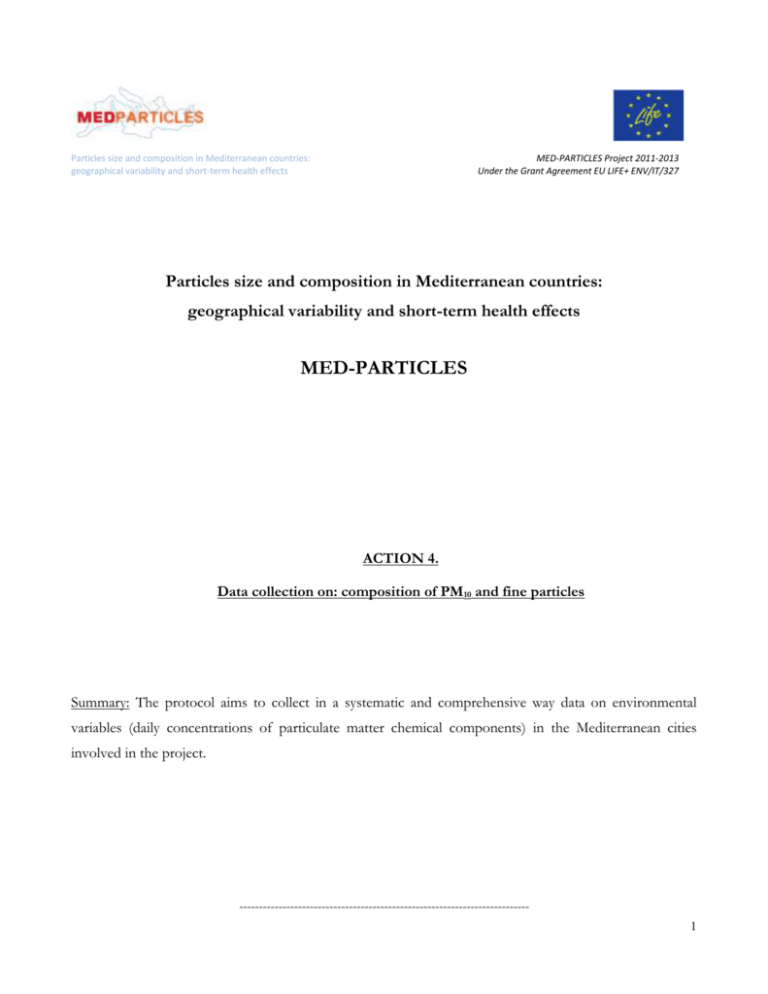
Particles size and composition in Mediterranean countries: geographical variability and short-term health effects MED-PARTICLES Project 2011-2013 Under the Grant Agreement EU LIFE+ ENV/IT/327 Particles size and composition in Mediterranean countries: geographical variability and short-term health effects MED-PARTICLES ACTION 4. Data collection on: composition of PM10 and fine particles Summary: The protocol aims to collect in a systematic and comprehensive way data on environmental variables (daily concentrations of particulate matter chemical components) in the Mediterranean cities involved in the project. -------------------------------------------------------------------------1 1. Objective The objective of this action is to collect environmental data (particle chemical components, gaseous components, meteorological parameters) adequate for health effects analysis of PM constituents and for source apportionment determination and effects analysis. Although a variety of suspended particles can be found in the atmosphere, there is consistency regarding their major components. Sulphate and organic matter are the main components of particulate air pollution in terms of particle mass. Mineral dust, nitrate, and soot can also be major components under certain conditions. The detailed knowledge of the chemical composition of particles, will allow apportioning the sources of particulate matter (PM) in the atmosphere. Other parameters like the concentrations of gaseous pollutants: CO, NO2, O3, SO2, and meteorological parameters: air temperature, relative humidity/dew point temperature, sea-level barometric pressure, wind speed/direction will be collected in order to assess their effect on PM emission sources. Statistical analyses will be used to discern which source categories contribute significantly to daily PM mass–mortality associations. 2. Methods 2.1 Targeted Chemical Species and analytical techniques The species of interest for the PM chemical speciation are listed below. Their selection is based on known major constituents of PM, capability of current analytical methods, availability of filter media, and known method performance characteristics. The chemical speciation data bases will consist of: Particulate Matter. The daily (24h) concentrations of PM will be collected from the existing monitoring networks of the involved cities in the project. Data on three different PM sizes will be collected: PM10, PM2.5 (fine fraction), PM2.5-10 (coarse fraction). It is advisable to collect PM mass data that derive from reference measurement methods. PM10 mass concentrations should be based on the European reference method EN 12341, which uses an unheated, filter-based gravimetric sampler. PM2.5 mass concentrations could derive by the reference method for PM2.5 measurement, EN 14907. Since PM2.5-10 mass might not be directly measured, it can be computed as the difference between PM10 and PM2.5 concurrent measurements. In the case that only hourly PM data are available (and not gravimetric data) these data can be used for the calculation of the daily averages. More details for this procedure are given in Action 3: Protocol for the collection of environmental data on daily concentrations of particles, gases and meteorological parameters) and Action 7. Water soluble ions. Particulate sulphate (SO4-2), nitrate (NO3-) and ammonium (NH4+) are major aerosol components thus their daily mass concentrations will be collected at all speciation sites. The analysis of other important ions such as chloride (Cl-) and sodium (Na+) is optional (depends on the availability of data) but should be included in coastal speciation sites. The most commonly used method for the determination of these ions is Ion Chromatography (IC). Aerosol particles are collected on filters and aqueous extracts of these filters are analyzed using IC for several anions and cations. In the absence of particulate sulphate (SO4-2) particulate sulfur concentrations can be used which are routinely analyzed by other techniques such as XRay fluorescence (XRF) and Inductively coupled atomic emission spectroscopy (ICP-AES). For 2 the determination of NH4+ a ion electrode can also be used although this method is less sensitive than IC. Elemental carbon (EC), Organic carbon (OC). There are currently no reference standards or standardized method for the determination of these carbon fractions. The most commonly used method is the thermal-optical analysis on quartz-fiber filters. Major Elements. The daily concentrations of silicon (Si), calcium (Ca), aluminium (Al), iron (Fe), magnesium (Mg), potassium (K) and sodium (Na) should be collected at all speciation sites. Several methods are being used for the determination of these elements: Inductively coupled atomic emission spectroscopy (ICP-AES), Atomic Absorption Spectroscopy (AAS), XRay Fluorescence (XRF) and Proton Induced X-Ray Emission (PIXE) are sensitive and accurate methods commonly used for the monitoring of these elements. Especially, XRF and PIXE techniques are adequate methods for silicon (Si) determination (a typical tracer for soil) while the other methods include a relatively high error. These two techniques, XRF and PIXE are non-destructive so the filters do not need any treatment before the analysis. However, the error in the determination of Na is extremely high. In the case that the elemental concentrations derive from XRF and/or PIXE measurements Na concentrations could be replaced by water soluble Na+ determined by ion chromatography. The other two methods AAS and ICP-AES require the treatment (digestion) of the filters with a mixture of acids prior to analysis. In order to calculate the total metal content it is essential to use a mixture of acids that includes hydrofluoric acid (HF) to dissolve the alumino-silicate matrix of the aerosol particles. However, these techniques do not permit the determination of Si. If Si concentrations are not available for one city, Si could be deleted from the data base. Trace elements. The daily concentrations of the following trace metals should be available for all speciation sites: titanium (Ti), vanadium (V), chromium (Cr), manganese (Mn), nickel (Ni), copper (Cu), cobalt (Co), zinc (Zn), arsenic (As), selenium (Se), antimoniium (Sb), barium (Ba), cadmium (Cd) and lead (Pb). These elements are tracers of various natural and anthropogenic emission sources. The adequate methods for the determination of trace elements concentrations are: Inductively coupled plasma - mass spectrometry (ICP-MS), Atomic Absorption Spectroscopy (AAS), X-Ray Fluorescence (XRF) and Proton Induced X-Ray Emission (PIXE). The acid digestion with hydrofluoric acid is again mandatory when ICP-MS and AAS are used. If some of these trace metals are not available for one city they could be deleted from the data base. Uncertainty of the chemical species. For all chemical species included in the database, the analytical uncertainty should be provided by each partner. Other data to be provided o o o Each city should provide a physical description of the monitor sites and equipment used (samplers, filters). Each city should report the details of the sampling (duration, frequency). Each city should report the analytical methods used for the determination of chemical species 3 o Each city should provide quality assurance/quality control QA/QC procedures that have been used. Each city should report the detection limits (LOD) for each of the PM constituents. Each city should report the percentage of each constituent that is below the LOD. o o Each series of target species requires sample collection on the appropriate filter medium and chemical analysis by methods of adequate selectivity, sensitivity and reliability. Table 1 provides a matrix of filter types, target species, and analytical methods. An example of the chemical speciation database is given in Table 2. Table 1. PM chemical speciation filters, target species and applied methods Filter Medium Target Species Analytical Techniques Quartz fiber, Teflon, glass PM10 fiber Reference method: EN12341 Quartz fiber, Teflon, glass PM2.5 fiber Reference method: EN 14907 Quartz fiber, Teflon, glass PM2.5-10 fiber Direct gravimetric measurement or PM2.5-10 =PM10 - PM2.5 Quartz fiber, Teflon, nylon, SO4-2, NO3-, NH4+, IC, (NH4+ could also be determined glass fiber Clby ion electrode) Thermal – optical analysis Quartz fiber EC, OC Quartz fiber, Teflon, nylon Si†, Ca, Al, Fe, Mg, ICP-AES*, AAS* XRF, PIXE K, Na‡ Quartz fiber, Teflon, nylon Ti, V, Cr, Mn, Ni, ICP-MS*, AAS* Cu, Co, Zn, As, Se, XRF, PIXE Sb, Ba, Cd, Pb *acid digestion with hydrofluoric acid is mandatory ‡ Na cannot be determined by XRF and PIXE. Na concentrations could be replaced by Na+ determined by IC † Si can be accurately determined only by XRF and PIXE Table 2. Example of the chemical speciation database for PM10 (PM10 and chemical species mass concentration is given in µg m-3) Date/µg m-3 PM10 OC EC SO4‗ NO3- NH4+ Cl- Si Ca Al Fe .. Zn As Se Ba Cd Pb dd/mm/yyyy ×× ×× ×× ×× ×× ×× ×× xx ×× ×× ×× .. ×× ×× ×× ×× ×× ×× dd/mm/yyyy ×× ×× ×× ×× ×× ×× ×× ×× ×× ×× .. ×× ×× ×× ×× ×× ×× …. …. …. …. …. …. …. .. …. …. …. …. …. …. …. …. …. …. 4 dd/mm/yyyy ×× ×× ×× ×× ×× ×× ×× ×× ×× ×× .. ×× ×× ×× ×× ×× ×× dd/mm/yyyy ×× ×× ×× ×× ×× ×× ×× ×× ×× ×× .. ×× ×× ×× ×× ×× ×× …. …. …. …. …. …. …. .. …. …. …. …. …. …. …. …. …. …. 2.2 Uncertainty of the chemical species Receptor-modeling techniques that incorporate the concentrations of aerosol components at a receptor site are widely used in source apportionment studies. Receptor models based on factor analysis techniques are used in the absence of a local source profile inventory. In the framework of MEDPARTICLES, Positive Matrix Factorization, PMF (an advanced receptor model) will be used to resolve the sources of particulate matter in the Mediterranean Basin. One of the main advantages of PMF is that it takes into account the uncertainty of each data point. For this reason each beneficiary should provide the analytical uncertainty/error for each chemical component in a separate table having the same format as Table 2. For each concentration value an uncertainty value should be provided. The analytical laboratories that have conducted the chemical analysis will be responsible to calculate the uncertainty of each chemical component. Table 3. Example of the uncertainty database for PM10 Date/µg m-3 PM10 OC EC SO4‗ .. .. Cl- Ba Cd Pb dd/mm/yyyy ×× ×× ×× ×× ×× ×× ×× ×× ×× ×× dd/mm/yyyy ×× ×× ×× ×× ×× ×× ×× ×× ×× ×× .. .. .. .. .. .. .. .. .. .. .. dd/mm/yyyy ×× ×× ×× ×× ×× ×× ×× ×× ×× ×× dd/mm/yyyy ×× ×× ×× ×× ×× ×× ×× ×× ×× ×× …. …. …. …. …. …. …. …. …. …. …. 2.3 Additional parameters Previous information concerning emission sources in the studied areas could be useful for source apportionment e.g: the composition of soil in each area, industrial activities in the proximity of the sampling sites etc. Furthermore events like construction activities close to the sampling site, wildfires etc. should be also reported. Each partner should provide this kind of information if available. Long term data series of specific tracers (e.g: EC for diesel emissions) could be used to investigate the correlation between these species and health outcomes. Hourly concentrations and daily averages of gaseous pollutants CO, NO2, O3, SO2. Gaseous pollutants data will be collected from the existing monitoring networks in the involved cities. More details for this procedure are given in Action 3: Protocol for the collection of environmental data on daily concentrations of particles, gases and meteorological parameters) and in Action 7. Hourly concentrations and daily averages on meteorological parameters (air temperature, relative humidity/dew point temperature, apparent temperature, sea-level barometric pressure, 5 wind speed/direction). For each city involved in the project, data on meteorological parameters: air temperature, relative humidity, apparent temperature, sea-level barometric pressure, wind speed/direction, will be collected. Data will be collected from the closest airport monitoring station, where available, or from another monitor located inside the city, if airport data are not available. More details are given in Action 3 and in Action 7. Conclusions: The protocol describe the methodologies, type of filters and analytical methodologies adopted to obtain chemical speciation data. The filters used are quartz filters, Teflon filters and nylon glass filters. The analytical methods adopted are: IC, thermal-optical analysis, ICP-AES, AAS, XRF, PIXE and the reference methods EN12341 and EN 14907. The target species to be collected are: particulate matter, water soluble ions, elemental carbon (EC), organic carbon (OC), major elements and trace elements. 6

